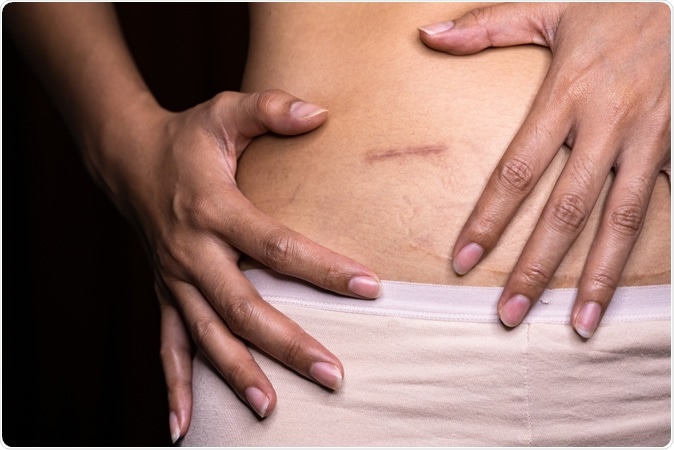A new study published in the journal JAMA Surgery in February 2020 shows that patients with acute appendicitis that were successfully treated either by antibiotics or by appendectomy had identical satisfaction with their treatment and identical quality of life over the long term. The patients who were first treated conservatively and then had appendectomy had lower satisfaction rates.
Appendicitis is the inflammation of a small finger-like organ attached to the beginning of the large bowel. This condition, if left untreated, sometimes progresses to form a pelvic abscess. This finding has led to the widespread belief that if acute appendicitis is demonstrated, an emergency appendectomy is the answer. This, however, overlooks the basic fact that antibiotics came to be widely used only 40 years later.

Appendicitis scar. Image Credit: Avigator Fortuner / Shutterstock
The study
The researchers looked at 423 patients in Finland who had been part of the Appendicitis Acuta (APPAC) study. The current study was a follow-up of this group at 7 years. The patients filled out questionnaires about their quality of life and satisfaction with their treatment.
The APPAC study
APPAC was a randomized clinical trial for the treatment of uncomplicated acute appendicitis. The trial randomly assigned half the patients to appendectomy and the other half to antibiotics.
About 60% of the patients on antibiotics recovered fully. This helped many physicians to switch to an initial non-operative approach for this condition. However, many others found much to dislike, from the fact that 40% of patients ultimately had to undergo surgery, that powerful antibiotics needed to be administered, and that the patient had to stay in hospital for three days, as well as the open surgery rather than laparoscopic surgical method used.
At the time of the APPAC study, a non-surgical approach to acute appendicitis was unheard of. To get enough cases in the study, the investigators were forced to compromise with the surgeons involved, that if in their judgment it was required, operative treatment could be given even to the patients in the non-surgical arm. The scenarios envisaged included signs of progressive infection, perforation of the appendix, or peritonitis.
Moreover, the antibiotics were probably stronger than strictly necessary because the trial was, in part, an attempt to prove the reliability of medical treatment in acute uncomplicated appendicitis. In short, the trial results provide a lower than the actual estimate of the favorable outcome of these patients when treated with antibiotics.
The findings
The results showed that patients who had successful treatment had similar rates of satisfaction with their treatment and similar quality of life. However, those patients who were first treated with antibiotics but later had an appendectomy were less satisfied with their treatment.
The study is limited by the fact that open surgery was used in the first part of the trial for appendectomy, because today laparoscopic appendectomy is the standard of care for this condition, due to the briefer stay in hospital and the reduction in postoperative pain.
The implications
In an accompanying editorial, Edward Livingstone points out that patients in either arm had no measurable difference in the quality of life or satisfaction with treatment. Even though those who failed to show adequate response to the antibiotic were eventually taken up for surgery, this does not change the fact that in the group who were successfully treated non-surgically, there is no evidence of lingering infection. The most feared complication of infection is its spread, which could cause disability or death unless appropriately managed.
The editorial concludes, “Future studies should refine the approach used by the APPAC investigators to better understand how to nonoperatively manage acute appendicitis.”
Journal reference:
Sippola S, Haijanen J, Viinikainen L, et al. Quality of Life and Patient Satisfaction at 7-Year Follow-up of Antibiotic Therapy vs Appendectomy for Uncomplicated Acute Appendicitis: A Secondary Analysis of a Randomized Clinical Trial. JAMA Surg. Published online February 19, 2020. doi:10.1001/jamasurg.2019.6028